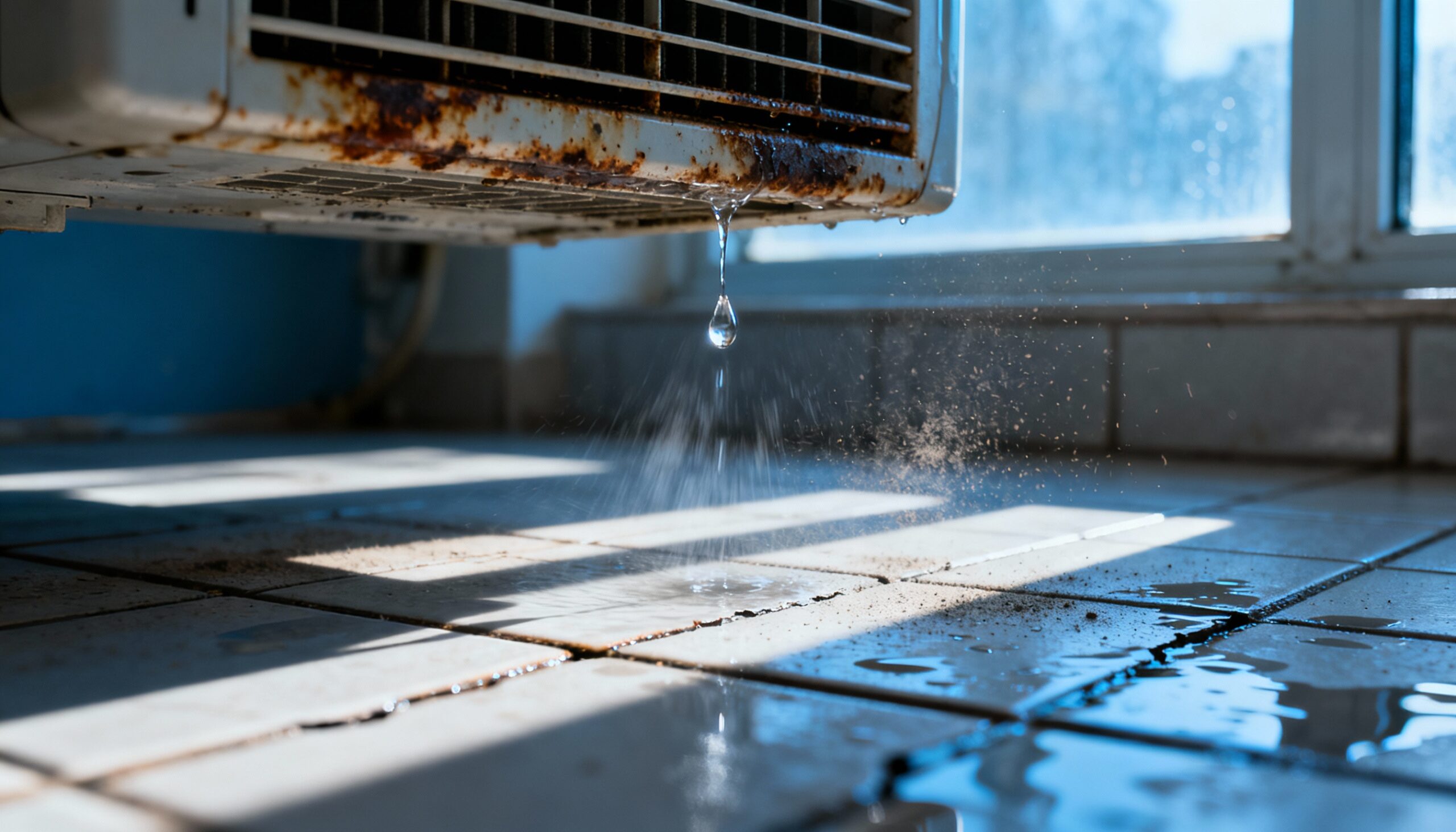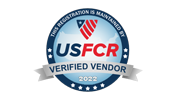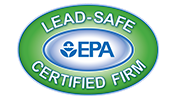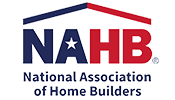What is HVAC Water Damage?
HVAC water damage refers to any moisture-related deterioration caused by or affecting heating, ventilation, and air conditioning systems. Unlike sudden plumbing failures, HVAC-related water issues often develop gradually through condensation, drainage problems, or system malfunctions. The damage can range from minor ceiling stains beneath air handlers to extensive structural deterioration and mold growth throughout ductwork.
These systems naturally produce moisture during operation—air conditioners generate condensate as they cool humid air, while heating systems can develop leaks from boiler components or steam pipes. When drainage systems fail or components malfunction, this moisture accumulates in walls, ceilings, and floor cavities where it often goes unnoticed until significant damage occurs.
The unique challenge with HVAC water damage lies in its hidden nature. Most residential and commercial systems have components concealed in attics, crawl spaces, and mechanical rooms. Water from a failed condensate pump might drip into wall cavities for weeks before visible staining alerts property owners to the problem.
Common Causes of HVAC Water Damage
Understanding why AC water damage and heating system leaks occur helps property owners implement effective prevention strategies. These causes vary by system type, age, and maintenance history.

Air Conditioning System Issues
Air conditioners remove humidity from indoor air, producing gallons of condensate daily during peak cooling season. A typical 3-ton residential AC unit generates 15-20 gallons of water per day in humid climates. When drainage systems fail, this water has nowhere to go except into your property structure.
Primary AC water damage causes include:
- Clogged condensate drain lines: Algae, mold, and debris accumulate in drain pipes over time, creating blockages that force water to overflow from the drain pan
- Cracked or rusted drain pans: Older units develop corrosion holes that allow water to leak directly into ceiling or floor cavities
- Failed condensate pumps: Units in basements or attics rely on pumps to move water upward; pump failures cause immediate backup and overflow
- Frozen evaporator coils: Restricted airflow or refrigerant issues cause coils to freeze, then flood the area when ice melts
- Improper installation: Incorrectly sloped drain lines prevent gravity drainage, leading to standing water and eventual overflow
Heating System Problems
Heating system leaks present different challenges than AC issues. Boilers, steam radiators, and hydronic heating systems contain water under pressure, making leaks potentially more damaging when they occur.
| Heating System Type | Common Leak Sources | Typical Warning Signs | Damage Risk Level |
|---|---|---|---|
| Boiler Systems | Pressure relief valves, heat exchangers, pipe connections | Water pooling near unit, pressure drops, rust stains | High – pressurized water |
| Steam Radiators | Valve packing, radiator seams, condensate returns | Hissing sounds, visible steam, water under radiators | Moderate to High |
| Hydronic Radiant | Manifold connections, in-floor tubing, expansion tanks | Warm wet spots on floors, pressure gauge fluctuations | High – hidden damage |
| Heat Pumps | Defrost drain pans, refrigerant lines, backup drain | Ice buildup, water stains, reduced heating | Moderate |
⚠️ Important: Heating system leaks often contain chemicals, rust, or other contaminants that can damage flooring, drywall, and personal property more severely than clean water. Professional restoration becomes critical when these substances are involved.
Ductwork and Ventilation Issues
Ductwork itself can become a source of water damage when condensation forms on cold surfaces or when leaks allow moisture infiltration. Poorly insulated ducts in humid attics or crawl spaces develop “sweating” that drips onto insulation and ceiling materials below.
Air handler units located in unconditioned spaces face similar condensation challenges. During cooling season, cold supply air meets hot attic temperatures, creating the perfect conditions for moisture accumulation on duct exteriors and surrounding structures.
Early Detection: Warning Signs of HVAC Water Damage
Catching HVAC water damage early dramatically reduces restoration costs and prevents secondary issues like mold growth. Property owners should watch for these indicators that suggest developing water problems.

Visual and Physical Indicators
- Ceiling or wall stains: Water rings, discoloration, or bubbling paint near HVAC components signal active or recent leaks
- Sagging ceiling tiles: Commercial drop ceilings absorb water and visibly sag when air handlers or ductwork leak above
- Standing water: Water pooling near indoor units, in mechanical rooms, or under air handlers indicates drainage failure
- Rust or corrosion: Visible rust on HVAC components suggests ongoing moisture exposure even when no active leak is present
- Musty odors: Mold developing in wet insulation, ductwork, or drain pans produces distinctive smells that intensify when the system runs
Performance Changes
HVAC systems experiencing water-related issues often show performance declines before visible damage appears. Pay attention to these operational changes:
- Reduced heating or cooling capacity despite normal thermostat settings
- Increased humidity levels that make indoor spaces feel clammy or uncomfortable
- Unusual sounds like dripping, gurgling, or hissing from ducts or equipment
- Frequent system cycling or failure to reach setpoint temperatures
- Rising utility bills without corresponding weather changes
💡 Pro Tip: Install water detection sensors near condensate drain pans, under air handlers, and in mechanical rooms. These inexpensive devices ($20-50 each) alert you to water presence before damage becomes extensive, potentially saving thousands in restoration work.
Professional Inspection Findings
Regular professional HVAC maintenance includes checks that homeowners can’t easily perform. Technicians use specialized tools to detect problems before they cause damage:
| Inspection Method | What It Detects | Recommended Frequency |
|---|---|---|
| Moisture meters | Hidden water in walls, ceilings, and insulation surrounding HVAC components | Annual or when issues suspected |
| Thermal imaging | Temperature differentials indicating wet insulation or active leaks behind surfaces | Bi-annually for commercial properties |
| Drain line pressure tests | Blockages or restrictions before they cause overflow situations | Every maintenance visit |
| Combustion analysis | Heat exchanger cracks in furnaces that can leak water and dangerous gases | Annually before heating season |
Prevention Strategies: Protecting Your HVAC Investment
Preventing AC water damage and heating system leaks costs significantly less than addressing the consequences. A comprehensive prevention program combines regular maintenance, environmental controls, and proactive monitoring.
Essential HVAC Maintenance Schedule
Consistent maintenance prevents most water damage incidents. Follow this schedule to keep your system operating safely:
Monthly tasks:
- Check condensate drain pan for standing water or debris accumulation
- Inspect visible ductwork for condensation or water stains
- Test condensate pump operation by pouring water into reservoir
- Replace air filters to maintain proper airflow and prevent coil freezing
Quarterly tasks:
- Pour condensate drain line cleaning solution through drain to prevent algae buildup
- Inspect heating system pressure gauges and look for unusual fluctuations
- Check visible pipe connections for corrosion, rust, or moisture
- Verify outdoor condensate discharge is flowing freely away from foundation
Annual professional maintenance:
- Complete system inspection including hidden components and drain pans
- Condensate drain line flushing and cleaning with specialized equipment
- Evaporator coil cleaning to prevent freezing and ensure efficient condensate removal
- Drain pan inspection and treatment with antimicrobial tablets
- Heating system pressure testing and safety valve inspection
- Ductwork insulation assessment in unconditioned spaces
Environmental Controls
Managing the environment around your HVAC system reduces water damage risk. These strategies address the conditions that contribute to condensation and drainage problems.
🏠 Home Tip: Maintain attic ventilation and insulation to reduce temperature differentials that cause ductwork condensation. Proper attic ventilation can reduce duct sweating by up to 60%, according to HVAC performance studies.
- Humidity management: Keep indoor humidity between 30-50% to reduce condensate production and prevent microbial growth in drain systems
- Proper insulation: Insulate all ductwork and refrigerant lines in unconditioned spaces to prevent condensation formation
- Adequate drainage: Ensure condensate discharge points drain away from foundations and don’t pool near the building
- Temperature control: Avoid extreme thermostat settings that force systems to work harder and produce more condensate
System Upgrades and Modifications
Some water damage prevention improvements require professional installation but provide long-term protection:
| Upgrade | How It Prevents Damage | Best For |
|---|---|---|
| Secondary drain pan | Catches overflow from primary pan before water enters structure | Attic air handlers, units above finished spaces |
| Condensate pump with alarm | Alerts when pump fails before backup occurs | Basement units, any system with pump |
| Float switch safety | Shuts system down if drain pan fills beyond safe level | All forced-air systems |
| UV light in drain pan | Prevents algae and microbial growth that causes clogs | High-humidity climates, vacation properties |
Professional HVAC Water Damage Restoration
When HVAC water damage occurs despite prevention efforts, professional restoration services ensure complete recovery and prevent long-term problems. The restoration process differs from standard water damage remediation because it must address both structural damage and HVAC system integrity.
When to Call Restoration Professionals
Some situations absolutely require professional intervention rather than DIY cleanup attempts:
- Water has been present for more than 24-48 hours, increasing mold risk significantly
- Damage affects multiple rooms, floor levels, or extends into wall cavities
- Water originated from heating system containing chemicals or contaminants
- Insulation, drywall, or structural materials show visible saturation
- HVAC ductwork or air handler interior has water exposure
- Electrical components or panels have moisture contact
⚠️ Important: Never operate HVAC systems that have experienced water exposure until a qualified technician inspects and approves them. Running damaged equipment can spread contamination, cause electrical hazards, and worsen existing damage.
The Professional Restoration Process
Complete HVAC water damage restoration follows a systematic approach that addresses both immediate water removal and long-term system protection.
Phase 1: Emergency response (0-24 hours)
- System shutdown and utility disconnection to prevent additional damage
- Water extraction from affected areas using commercial equipment
- Moisture mapping to identify all affected materials including hidden damage
- Immediate air movement setup to prevent mold development
- Documentation with photos and moisture readings for insurance purposes
Phase 2: Drying and dehumidification (1-5 days)
- Industrial dehumidification equipment placement targeting affected areas
- Strategic air mover positioning for maximum drying efficiency
- Daily moisture monitoring in walls, ceilings, and structural materials
- HVAC system component assessment and cleaning or replacement recommendations
- Antimicrobial treatment for affected surfaces to prevent microbial growth
Phase 3: Restoration and repair (Variable timeline)
- Removal and replacement of materials that cannot be adequately dried
- HVAC system repairs or component replacement as needed
- Ductwork cleaning and sanitization if contaminated
- Drain line upgrades and prevention system installation
- Final moisture verification ensuring all materials reach dry standards
Ductwork and Indoor Air Quality Considerations
Water exposure in ductwork creates unique challenges for indoor air quality. Porous duct materials like fiberglass duct board cannot be effectively cleaned once wet—they require replacement to prevent ongoing mold problems. Metal ductwork can often be cleaned and sanitized, but only after thorough moisture removal and proper treatment.
Professional restoration includes post-drying air quality testing when ductwork has been affected. This verification ensures that remediation successfully eliminated contaminants rather than simply hiding them behind clean-looking surfaces.
Insurance and Documentation Best Practices
Proper documentation of HVAC water damage significantly impacts insurance claim outcomes. Start documenting immediately when you discover water damage, before any cleanup begins.
Critical documentation includes:
- Photos and videos of water source, affected areas, and damaged contents
- Maintenance records showing regular HVAC service and drain line cleaning
- Utility bills demonstrating normal system operation before the incident
- Professional inspection reports detailing damage extent and causes
- Itemized list of damaged contents with approximate ages and values
💡 Pro Tip: Many insurance policies require prompt notification of water damage—typically within 48-72 hours of discovery. Contact your insurance company immediately, even if you’re unsure whether damage exceeds your deductible. Late notification can jeopardize coverage.
Long-Term System Protection
Recovering from HVAC water damage provides an opportunity to implement enhanced protection measures that prevent recurrence. Property owners should view restoration as the foundation for improved system monitoring and maintenance practices.
Monitoring Technology
Modern smart home systems include HVAC-specific monitoring that alerts property owners to developing problems before damage occurs. These systems track condensate line pressure, drain pan water levels, and even unusual moisture patterns near HVAC equipment.
Remote monitoring proves especially valuable for vacation properties, rental units, or commercial buildings with limited on-site supervision. Real-time alerts sent to smartphones allow for immediate response when drainage issues or leaks develop.
Professional Service Agreements
Regular professional HVAC maintenance through service agreements provides the most reliable protection against water damage. Quality maintenance contracts include:
- Scheduled preventive maintenance visits addressing water damage risk factors
- Priority emergency service when problems develop
- Detailed inspection reports documenting system condition over time
- Parts and labor coverage for common failure points like condensate pumps
- Proactive replacement recommendations before components fail catastrophically
The maintenance investment typically represents 1-2% of total HVAC system value annually but can prevent damage that costs 5-10 times that amount.
Commercial vs. Residential Considerations
Commercial properties face unique HVAC water damage challenges due to system size, complexity, and business interruption potential. Large commercial HVAC systems produce significantly more condensate—a 25-ton rooftop unit can generate 60+ gallons daily in humid conditions.
| Factor | Residential Impact | Commercial Impact |
|---|---|---|
| System complexity | Usually single condensate drain system | Multiple zones, numerous drain points to monitor |
| Access challenges | Attic or basement, relatively easy access | Rooftop units, mechanical rooms requiring special access |
| Damage consequences | Property damage, temporary discomfort | Business interruption, liability, inventory loss |
| Maintenance requirements | Annual or bi-annual service typically sufficient | Quarterly or monthly inspections necessary |
Commercial property managers should implement formal HVAC water damage prevention programs including regular inspections, documented maintenance schedules, and emergency response protocols. The business interruption cost from HVAC water damage often exceeds direct repair expenses.
Seasonal Considerations and Weather Impacts
HVAC water damage risk varies significantly by season. Understanding these patterns helps property owners adjust prevention efforts throughout the year.
Summer Challenges
Cooling season creates the highest AC water damage risk due to maximum condensate production. Systems running continuously in humid climates generate constant water flow that stresses drain lines and pumps. Summer is also when algae growth peaks in drain systems, increasing clog probability. Having access to reliable emergency cooling services ensures you can address problems quickly before water damage escalates.
Check condensate drainage weekly during peak cooling season. A sudden decrease in outdoor discharge indicates developing drain line problems even before overflow occurs inside.
Winter Risks
Heating system leaks increase during cold weather when boilers and steam systems operate at maximum capacity. Thermal expansion and contraction stress pipe connections and valve packing, creating new leak points. Frozen condensate lines from heat pumps can cause sudden overflow when systems switch to defrost mode. Professional emergency heating services become critical when these winter-related failures occur.
Maintain minimum temperatures in occupied spaces to prevent freeze-related damage. Buildings with heating system leaks in winter often face compounded damage when water freezes, expands, and affects larger areas.
Transition Periods
Spring and fall shoulder seasons present unique challenges as systems alternate between heating and cooling modes. This cycling can reveal problems that remained dormant during single-mode operation. Schedule professional inspections during these transition periods to catch developing issues before extreme weather demands arrive.
DIY vs. Professional Response Decision Tree
Property owners often struggle to determine when DIY cleanup suffices versus when professional restoration becomes necessary. Use this framework to make informed decisions:
Appropriate for DIY response:
- Minor overflow from drain pan, water completely contained to hard surfaces
- Water discovered and cleaned within 2-3 hours of occurrence
- No porous materials (drywall, insulation, carpeting) affected
- Simple condensate drain line clog clearly identified as the source
- No electrical component exposure to water
Requires professional restoration:
- Water present for unknown duration or exceeding 24 hours
- Porous building materials show saturation or staining
- Multiple areas affected or damage extends into wall/ceiling cavities
- Heating system leak with contaminated water
- Visible mold growth or strong musty odors present
- HVAC system operation uncertain or components potentially damaged
When in doubt, contact restoration professionals for assessment. Most companies offer free inspections that provide clarity on damage extent and necessary remediation steps. Early professional involvement often reduces total restoration scope by preventing damage progression.
Frequently Asked Questions
How quickly does HVAC water damage lead to mold growth?
Mold can begin developing within 24-48 hours when materials remain wet. HVAC-related water damage creates ideal mold conditions because the moist environment often combines with cellulose materials like drywall and insulation plus the warm temperatures HVAC systems maintain. This accelerated timeline makes immediate water removal and drying critical for preventing secondary mold problems that complicate restoration.
Can I prevent AC water damage by just checking the drain line regularly?
Regular drain line checking helps but doesn’t address all AC water damage causes. Comprehensive prevention requires checking drain lines, inspecting drain pans for cracks, testing condensate pump operation, maintaining proper airflow to prevent coil freezing, and ensuring correct system installation. Professional maintenance catches problems like corroded pans or restricted drain slopes that visual checks miss.
What’s the difference between AC water damage and heating system leaks?
AC water damage typically involves clean condensate from humidity removal, while heating system leaks may contain chemicals, rust, or contaminants from boiler treatment additives. Heating leaks often occur under pressure, causing more rapid damage spread. AC problems usually develop gradually from drainage issues, giving more warning time. Both require professional restoration, but heating system leaks need additional contamination control measures during cleanup.
How often should I have professional HVAC maintenance to prevent water damage?
Residential systems need professional maintenance annually before cooling season, with additional inspection before heating season in climates with significant winter heating demands. Commercial properties benefit from quarterly maintenance given their larger systems and higher condensate production. Properties in humid climates or those with previous water damage history should consider bi-annual professional service regardless of property type.
Will my homeowners insurance cover HVAC water damage?
Coverage depends on damage cause and your specific policy. Sudden failures like burst boiler pipes or cracked drain pans typically receive coverage, while damage from neglected maintenance often does not. Insurance companies examine maintenance records to determine if proper care could have prevented the incident. Document all HVAC maintenance, keep service receipts, and notify insurers promptly when damage occurs to maximize coverage potential.
Can HVAC water damage affect my property’s indoor air quality long-term?
Yes, inadequately addressed HVAC water damage creates ongoing indoor air quality problems. Moisture in ductwork or behind walls supports mold growth that HVAC systems then distribute throughout the property. Damaged insulation around ducts loses effectiveness and can harbor contaminants. Professional restoration with proper drying, antimicrobial treatment, and air quality testing ensures water damage doesn’t compromise your indoor environment for years after the initial incident.
Take Action: Protect Your Property from HVAC Water Damage
HVAC water damage threatens both residential and commercial properties, but understanding prevention strategies, recognizing early warning signs, and knowing when to call professionals dramatically reduces your risk. Whether you’re managing a single-family home or overseeing commercial facilities, implementing regular HVAC maintenance schedules and environmental controls provides the foundation for long-term system protection.
Don’t wait until you see ceiling stains or smell musty odors to address potential HVAC water issues. Schedule your annual maintenance now, install water detection sensors, and create a monitoring routine that catches problems early. When water damage does occur despite your best prevention efforts, rapid professional response minimizes both restoration requirements and business or lifestyle interruption.
Advanced DRI specializes in HVAC-related water damage restoration, combining water damage expertise with understanding of how heating and cooling systems contribute to property damage. Our technicians assess not just the visible damage but also the HVAC system factors that caused the problem, implementing solutions that restore your property while preventing recurrence.

